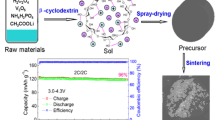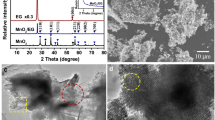Abstract
Lithium-rich manganese oxide (Li2MnO3) is prepared by reverse microemulsion method employing Pluronic acid (P123) as a soft template and studied as a positive electrode material. The as-prepared sample possesses good crystalline structure with a broadly distributed mesoporosity but low surface area. As expected, cyclic voltammetry and charge–discharge data indicate poor electrochemical activity. However, the sample gains surface area with narrowly distributed mesoporosity and also electrochemical activity after treating in 4 M H2SO4. A discharge capacity of about 160 mAh g−1 is obtained. When the acid-treated sample is heated at 300 °C, the resulting porous sample with a large surface area and dual porosity provides a discharge capacity of 240 mAh g−1. The rate capability study suggests that the sample provides about 150 mAh g−1 at a specific discharge current of 1.25 A g−1. Although the cycling stability is poor, the high rate capability is attributed to porous nature of the material.











Similar content being viewed by others
References
Winter M, Brodd RJ (2004) What are batteries, fuel cells, and supercapacitors. Chem Rev 104:4245–4269
Matsuki K, Ozawa K (2009) Lithium ion batteries. Wiley, Tokyo
Wittingham MS (2004) Lithium batteries and cathode materials. Chem Rev 104:4271–4301
Thackeray MM (1997) Manganese oxides for lithium batteries. Prog Solid State Chem 25:1–71
Rossouw MH, Thackeray MM (1991) Lithium manganese oxides from Li2MnO3 for rechargeable lithium battery applications. Mater Res Bull 26:463–473
Kalyani P, Chitra S, Mohan T, Gopukumar S (1999) Lithium metal rechargeable cells using Li2MnO3 as the positive electrode. J Power Sources 80:103–106
Johnson CS, Korte SD, Vaughey JT, Thackeray MM, Bobinger TE, Shao YH, Hackney SA (1999) Structural and electrochemical analysis of layered compounds from Li2MnO3. J Power Sources 81–82:491–495
Tang W, Kanoh H, Wang KOY (2000) Preparation of a new type of manganese oxide by selective lithium extraction from monoclinic Li2MnO3 for lithium rechargeable batteries. J Mater Sci Lett 19:1361–1363
Robertson AD, Bruce PG (2002) The origin of electrochemical activity in Li2MnO3. Chem Comm 23:2790–2791
Armstrong AR, Robertson AD, Bruce PG (2005) Overcharging manganese oxides: extracting lithium beyond Mn4+. J Power Sources 146:275–280
Pasero D, McLaren V, De Souza S, West AR (2005) Oxygen nonstoichiometry in Li2MnO3: an alternative explanation for its anomalous electrochemical activity. Chem Mater 17:345–348
Park SH, Sato Y, Kim JK, Lee YS (2007) Powder property and electrochemical characterization of Li2MnO3 material. Mater Chem Phys 102:225
Yu DYW, Yanagida K, Kato Y, Nakamura H (2009) Electrochemical activities in Li2MnO3. J Electrochem Soc 156:A417–A424
Lim J, Moon J, Gim J, Kim S, Kim K, Song J, Kang J, Im WB, Kim J (2012) Fully activated Li2MnO3 nanoparticles by oxidation reaction. J Mater Chem 22:11772–11777
Yang XY, Li Y, Lemaire A, Yu BJG, Su L (2009) Hierarchically structured functional materials: synthesis strategies for multimodal porous networks. Pure Appl Chem 81:2265–2307
Boutonnet M, Kizling J, Marie PSG (1982) The preparation of monodisperse colloidal metal particles from microemulsions. Colloids and Surfaces 5:209
Kleitz F, Choi SH, Ryoo R (2003) Cubic Ia3d large mesoporous silica: synthesis and replication to platinum nanowires, carbon nanorods and carbon nanotubes. Chem Comm 17:2136–2137
Sinha NN, Munichandraiah N (2009) Synthesis and characterization of carbon-coated LiNi1/3Co1/3Mn1/3O2 in a single step by an inverse microemulsion route. ACS Appl Mater Interface 1:1241–1249
Sinha NN, Shivakumara C, Munichandraiah N (2010) High rate capability of a dual-porosity LiFePO4/C composite. ACS Appl Mater Interface 2:2031–2038
Sinha NN, Munichandraiah N (2010) High rate capability of porous LiNi1/3Co1/3Mn1/3O2 synthesized by polymer template route. J Electrochem Soc 157:A647–A653
Strobel P, Andron BL (1988) Crystallographic and magnetic structure of Li2MnO3. J Solid State Chem 75:90–98
Jain G, Yang J, Balasubramanian M, Xu JJ (2005) Synthesis, electrochemistry, and structural studies of lithium intercalation of a nanocrystalline Li2MnO3-like compound. Chem Mater 17:3850–3860
Burton AW, Ong K, Rea T, Chan IY (2009) On the estimation of average crystallite size of zeolites from the Scherrer equation: a critical evaluation of its application to zeolites with one-dimensional pore systems. Microporous Mesoporous Mater 117:75–90
Yu DYW, Yanagida K (2011) Structural analysis of Li2MnO3 and related Li–Mn–O materials. J Electrochem Soc 158:A1015–A1022
Park B, Kim YJ and Cho J (2004) in: Lithium batteries: Science and Technology, G. A. Nazri, G. Pistoia. Kluwer, Boston
Park SH, Ahn HS, Park GJ, Kim J, Lee YS (2008) Cycle mechanism and electrochemical properties of lithium manganese oxide prepared using different Mn sources. Mater Chem Phys 112:696–701
Acknowledgments
The authors thank Renault Nissan Technology and Business Centre India Pvt. Ltd. for financial support, and Dr. Subramani and Dr. Arockia Vimal for helpful discussions. The authors also thank Dr. C. Shivakumara for his help in analysis of XRD patterns.
Author information
Authors and Affiliations
Corresponding author
Rights and permissions
About this article
Cite this article
Penki, T.R., Shanmughasundaram, D. & Munichandraiah, N. Polymer template-assisted microemulsion synthesis of large surface area, porous Li2MnO3 and its characterization as a positive electrode material of Li-ion cells. J Solid State Electrochem 17, 3125–3136 (2013). https://doi.org/10.1007/s10008-013-2221-1
Received:
Revised:
Accepted:
Published:
Issue Date:
DOI: https://doi.org/10.1007/s10008-013-2221-1




